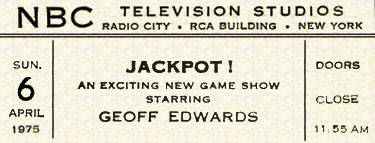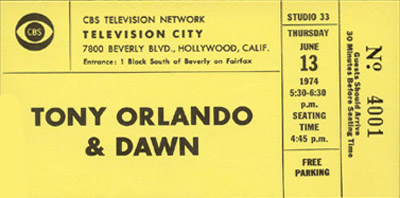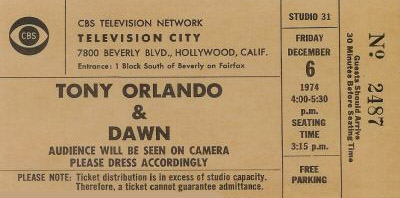Jackpot!

Jackpot! was an extremely new game show that went on NBC in 1974…a show that was supposed to usher in a new era in daytime television. Although the series itself did not succeed, a number of its innovations did become somewhat standard in the world of game shows. One was to go for a more “open” look. Instead of a set that enclosed the action in three cramped walls, the stage was wide open with a less claustrophobic feel. The other change was to go for a younger, sexier host…someone who might appeal to housewives in a way that most of the usual hosts did not.
That host, hand-selected by NBC exec Lin Bolen, was Geoff Edwards. She rejected dozens of candidates in New York (where Jackpot! would be taped) and instead, Edwards would be flown in most weekends from Los Angeles where he did a Monday-Friday radio show on station KMPC. She also reportedly supervised a new hairstyle for Edwards, as well as a whole new wardrobe that consisted mostly of the then-popular leisure suits.
Jackpot! was about riddles. Sixteen contestants would compete for a week at a time and at any given time, one would be designated as King of the Hill (or Queen, as applicable). When you were King/Queen, the others would read you the riddles and as long as you kept answering correctly, you’d continue playing and the jackpot would continue building. When you happened on the Jackpot Riddle!, a correct answer would cause the pot to be divided between you and the person who’d asked you the riddle.
Jackpot! replaced The Who, What or Where Game on the NBC schedule but not in the same time slot. Jeopardy!, which was then NBC’s most popular daytime program, was relocated there and the Jeopardy! time slot went to the new program. As explained on our page for the displaced show, its producer — Merv Griffin — was unhappy to see his series bumped to a new time so that Bolen could give every possible chance to Jackpot!, which was one of the first shows she supervised at the network. And then Bolen was unhappy that Jackpot! failed to click with viewers. It got consistently lower ratings than Jeopardy! and went off the air in September of 1975. (Some credited the failure with costing NBC its dominance in daytime. Jeopardy! was also cancelled and thereafter, soap operas on CBS and ABC ruled the morning hours.)
But Jackpot! had two afterlives, both with essentially the same format and set. A 1985 version was produced in Canada, primarily for airing on the USA Network in this country. It was hosted by Mike Darrow and lasted until 1989. Shortly after, a third version was produced for syndication in Southern California with Edwards returning to the host position. This one went unseen in many cities and failed after one year when its distributor collapsed. All of these were produced by Bob Stewart Productions, which had better luck with different incarnations of The $10,000 Pyramid.
Tony Orlando & Dawn


Before he “made it,” Tony Orlando drifted back and forth between working behind the scenes in the record business and in front of the microphone. Once he and two back-up singers scored big with “Candida,” “Knock Three Times” and “Tie a Yellow Ribbon ‘Round the Ole Oak Tree,” TV execs came calling, hoping the replicate the success of Sonny and Cher in a variety format. Orlando and the two ladies who comprised Dawn (Telma Hopkins and Joyce Vincent Wilson) didn’t quite have the same knack for snappy and mutually-insulting banter but their show had enough music and enough energy, as well as a stellar array of guests. It debuted as a summer series in 1974 and managed to stick around until December of ’76. For its last gasp, it was renamed The Tony Orlando and Dawn Rainbow Hour, as a way of signalling that it was undergoing some kind of unspecified revamp. The new title doesn’t seem to have meant much difference to anyone.
The reference on one of the above tickets to the audience being seen on camera refers to a weekly segment in which Orlando would wade out into the crowd, perform in the aisles and sometimes get audience members up to sing and dance with him. It became a signature routine of his and one that sparked battles amidst the show’s production staff and at the network, some of whom felt it was amateurish. The live audience loved it (no surprise) and each week, the producers would way overtape such material, then quarrel in the editing room over how much to include. There’d be pointed arguments that every song that Tony performed with a fat lady in an aisle seat meant they’d have to cut out a polished, rehearsed musical spot with one of the show’s well-paid and professional guest stars. On the other hand, even those who fought for less audience numbers had to admit that Tony was never better than when he and his fans were energizing one another. He had a genuine love for the people who came to see his shows tape (and vice-versa) and that probably is what is best remembered from that series.






